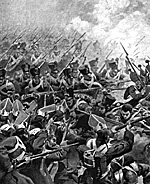The Battle Of Durnstein
11th Nov 1805
Wargamed
by Steve Bainbridge U.K
| |
This article is written partly in response to Patrick Wilson's excellent "Combat at Soldau" in FE 37. In his opening paragraph Patrick mentioned the difficulties of finding suitable battles of the right size for use as war games scenarios. In his list of examples I recognized half a dozen that I and my friends had re-fought over the years. Although some I had discovered myself, most I had found in articles like Patrick's. I thought it was about time after 25 years of war gaming I gave back something to other enthusiasts. The final prompt came whilst checking some uniform details of Austrian grenadiers in a 1973 Wargamer's Newsletter (remember that?) and noticing that the article was written by a certain John Cook!.
Since the Austrian capitulation at Ulm on 20th October Kutusov's Russians had been pursued along the south or right bank of the Danube. Half hearted attempts to delay the French at the various tributaries of the Danube had been made. The Austrian force under Meerveldt was lost and destroyed due to confusion over orders. Kutusov was probably relieved to escape to the north or left bank of the Danube at Krems on the 9th Nov. At this point Murat with his cavalry reserve raced off to capture the prize of Vienna which Kutusov's withdrawal over the Danube had left uncovered. Worse still Murat dragged along both Lannes and Soult's corps. This gave the Russians a much needed respite, morale may have been raised by the arrival of reinforcements. Kutusov was now in a strong position, in which freed from the need to escape from Napoleon; he could think of acting offensively. He knew that the French VIII corps under Mortier had moved across the Danube to the north bank, up stream at Linz. Mortier's corp had become dangerously strung out with Gazan's division of only 6,000 well ahead of the other two divisions. On the night of 10/11th November Gazan's division halted at Durnstein only 3 miles upstream of Kutusov at Krems with 40,000 troops. The attempt to destroy a major French force and to clear them from the north bank of the Danube was to be made next morning the 11th November 1805.
The plan was that Miloradovich should attack frontally along the river bank whilst Strik marched through the hills and attacked the French flank. Dokhturov was to march further and appear in the French rear encircling them. Altogether the Russians employed 15,000 men. The French held the attack even when in the afternoon Strik duly appeared on the flank. Delayed in the hills it was not until 5pm that Dokhturov appeared in the French rear. However Mortier's second division under Dupont ( Later responsible for the disgraceful surrender at Baylen in 1808) now appeared in Dokhturov's rear having hurried to the sound of gunfire. Both forces were now surrounded and the battle became desperate.In the darkness the Russians were driven off at a heavy price. Mortier's battered corp withdrew to the south bank next day by boat. According to Chandler Mortier at one point was worried enough to embark his guns in 3 of the 14 barges available so as to save them.
Miloradovich
Strik Dokhturov An infantry regiment would have 2 musketeer and 1 grenadier battalion.
A grenadier regiment would have 1 grenadier and 2 fusileer battalions.
Despite their name the Fusileer battalions would appear to have no light infantry role and I treated them as having higher morale than line troops but lower than grenadier morale.
For the 3 battalions in Miloradovich and Strik's commands I used 2 jaeger and 1 line each.
The details of Dokthurov's forces are guestimates based on the historical ratios of types of infantry and the figures I had available.
I gave Miloradovitch a battery to even things out. Dokthurov is specifically mentioned as leaving his guns behind and Strik as not having any. By implication Miloradovich may have had some. In any case it balances the game well.
My Russians are 20 figures to a battalion except the jaeger at 16. The hussars at 8 figures seemed correct and the battery had 6 gunners (12 guns) a total of 450 figures or 15000 men at a scale of 33:1.
1st brigade 2nd brigade 3rd brigade Artillery Barges My information is pretty sparse. I have based the likely divisional structure on Chandler's campaigns of Napoleon p 347 which shows St Hilaire's division at Austerlitz 3 weeks later.
The total of 10 battalions at 18 figures adds up to 6,000 men at a scale of 33:1 .
The 4th legere and the guns are mentioned specifically by Duffy.
I have used the same composition for Dupont's division except for the barges..
The game was played on a 4' x 6' table which is covered in 4" hexes. As I knew the Russian reinforcements I played the Russians and informed my opponent Martin only that the division of Dupont was within supporting distance. The game starts at 0900 with half hour turns and darkness falling at 1700. At this point units become tired for - 1 morale, melee and firing. After a further 2 hours they are exhausted for -2 on these factors. The division of Gazan starts on the table with a battalion or battery in each building of Durnstein or Loiben or each tent symbol. (Yes I now the French did not use them but I have some tent models and they do not get used much!). The Russians start the game with Miloradovich's forces entering at point A. Reinforcements arrive in column on the first turn possible on a 6 on a D6 with plus 1 on the die role each later turn so that after 6 turns they must arrive. . .
Strik 12.00 point B. |
